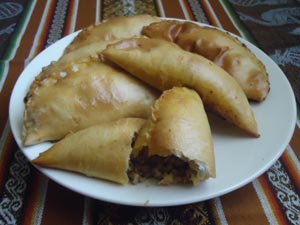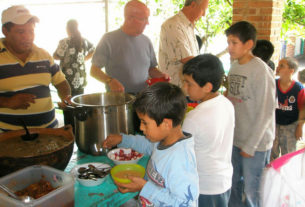It would be difficult to think of a food more versatile than the empanada except, of course, the taco. Both consist of a dough-based wrapper around a filling, and both can hold a huge variety of ingredients within. But while the taco has its roots in the indigenous Mexican culinary tradition, the empanada was an import from both Spain and, in the form of Hidalgo’s pastes, from Cornwall.

Empanadas are found all over Mexico, in several different forms, from the corn dough empanadas filled with local fish in tropical Tabasco, to the plantain dough empanadas of Veracruz, stuffed with a beef and pork picadillo seasoned with olives and raisins, a typically Spanish combination.
Another empanada specialty of Veracruz, sold in the streets throughout the port city, is the volovan, a linguistic and culinary variation of the French vol-au-vent, or puff pastry. In Veracruz, volovanes are most commonly filled with either tuna or pineapple, and frequently with chicken or a ham and cheese combination. They make a great street snack, with a soft, satisfying crunch as the first bite of flaky pastry releases its filling, either sweet or savory, whichever appeals at the moment.
In Chiapas, empanadas chiapacorceñas are stuffed with spiced pork and, in Central Mexico, a filling is made with the pumpkin-like winter squash that appears around Day of the Dead, combined with mushrooms, sometimes the wild ones harvested from the volcanic slopes of Popocatepetl or the Sierra de Puebla. Wheat dough is used to encase the filling, as it is with the classic pastes, or Cornish pasties, of Hidalgo. But while pastes came with the Cornish miners, Mexican empanadas, like those of much of Latin America, came from Spain.
Their appearance in medieval Spain coincided with the invasion of the Moors, who most likely adapted them from the tradition of filled pastries that made its way from India to the Middle East. The Spanish word empanada comes from the verb empanar — to coat with bread crumbs or dough. What is believed to be the first Iberian cookbook with a recipe for empanadas was the Catalonian Libre del Coch, published in 1520.
The Spanish took quickly to empanadas, filling them with a variety of seafood, fish, meat, cheese, vegetables and fruit. In Mexico, this portable pocket, in all its regional variations, can be served at breakfast, as a snack, a dessert, or on a party table. The dough can be made with wheat, corn, plantains, and even yucca. Sweet empanadas — usually filled with fruit, especially pineapple, guava or apple — are sometimes drizzled with syrup or dusted with sugar.
Empanadas make a great buffet item, and can be fried or baked, served warm or at room temperature. They can be baked ahead and frozen, or frozen unbaked, preferably individually wrapped to prevent freezer burn. Unwrap and heat frozen, pre-baked empanadas in a low to moderate oven. Frozen unbaked empanadas should be baked at 425°F for 20-25 minutes, depending on the oven. In either case, thawing first is not necessary.
I do not recommend freezing empanadas made with any but wheat dough, as other types of dough do not hold together well in the freezer. And even with wheat dough empanadas, I advise against reheating in the microwave, since this toughens the dough.
Fried empanadas should be made fresh, or made ahead and frozen without being fried first. If frozen, they should be completely thawed before frying. Once thawed, cook them in hot vegetable oil, about 350°F, turning until golden brown on both sides, and drain thoroughly on paper towels.
Whether fried or baked, empanadas must be thoroughly sealed. After rolling out the dough into rounds, fill with the ingredient of your choice, fold over into a crescent shape, and seal by either pinching the edges or using the tines of a fork.
Some people roll the edges into an attractive shape, but those are the people who make picture perfect pie crust, and I am not one of them. I use the fork method, and after gently pressing the tines on one side, I turn the empanada over and do the same on the other side. This ensures a good seal and avoids any leakage, which will invariably burn on the baking sheet. Lining the baking sheets with parchment paper makes cleaning up easy. Alternatively, grease the baking sheets.
Empanadas are good any time and for any occasion. Mini empanadas are nice to serve with cocktails, since all they require is one hand and a small napkin. Improvise with everything from fruit filling to leftovers, including roasted meat, shredded and seasoned, or baked sweet potatoes, mashed and sweetened. Try one of these regional Mexican empanada recipes, whether vegetarian, meat, fish or fruit, made from wheat, corn or plantain dough, fried or baked, and invite some friends for an empanada tasting.
- Veracruz style empanadas with tuna: Volovanes de Minilla
- Chiapas style pork empanadas: Empanadas chiapacorceñas
- Yucatan style chaya empanadas: Empanadas de chaya
- Mexican mini chicken chipotle empanadas: Mexican empanaditas de pollo con chipotle
- Tabasco style fish empanadas: Empanadas de pescado
- Mexican plantain empanadas with picadillo: Empanadas de platano
- Mexican pineapple empanadas: Empanadas de piña
- Mexican mushroom and pumpkin empanadas: Empanadas de champiñones y calabaza



